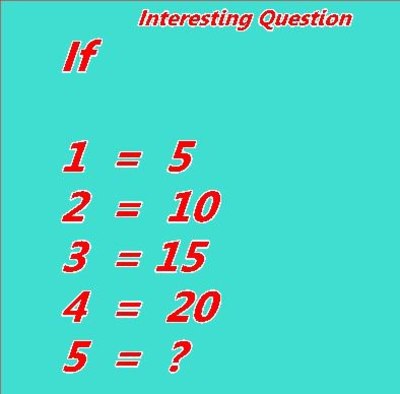The popular puzzle revisited!

The image shows a popular puzzle, which can be seen frequently online. In fact, the statement of the problem doesn't make sense from the mathematical perspective. But I'll dive it a little deeper.
What the designer of the problem really means is to define a sequence { a n } , so that:
a n = { k , ∃ k < n ( k ∈ N + ) , a k = n 5 n , otherwise
Find k = 1 ∑ 2 0 2 0 a k .
The answer is 8567810.
This section requires Javascript.
You are seeing this because something didn't load right. We suggest you, (a) try
refreshing the page, (b) enabling javascript if it is disabled on your browser and,
finally, (c)
loading the
non-javascript version of this page
. We're sorry about the hassle.
4 solutions
What about multiples of 5 3 and and multiples of 5 4 ?
Log in to reply
I think they fit into either of the categories 1 or 2. don't they?
Log in to reply
As one example, your statements would put k = 1 2 5 in category 1 , which would make a 1 2 5 = 6 2 5 . However, it should be a 1 2 5 = 2 5 , because a 2 5 = 1 2 5 .
Log in to reply
@David Vreken – Now I get your point, that is correct. Then, my solution is wrong, which probably makes the final answer wrong. You are such an early bird anyways!
Log in to reply
@Alexander Shannon – Oh, I think I've got the same problem. I will post a revised program here.
@Alice Smith could you please share with us the way you got the answer?
1 2 3 4 5 6 7 8 9 |
|
Using Excel.
Column A and column C : from 1 to 2020.
Column B : each cell contains the expression IFERROR(VLOOKUP(An; $B$1 : C_(n-1); 2 ; FALSE); An*5) .
D1 = sum(B1:B2020) gives the answer 8567810 .
First: The solution is incorrect. The answer should be 8 5 6 7 8 1 0 :
The revised Wolfram code is as follows:
1 2 3 4 |
|
Which would get 8 5 6 7 8 1 0 .
But David is still upset. How are u gonna make that up to him?
Log in to reply
No worries. We've discussed that in the report, so the administrator will change the answer.
Log in to reply
Good on you!
1- a k = 5 ⋅ k iff 5 ∤ k or 2 5 ∣ k
2- a k = 5 k iff 5 ∣ k , 2 5 ∤ k
Based on the deductions above and using a version of Inclusion-Exclusion principle ,
k = 1 ∑ 2 0 2 0 a k = 5 k = 1 ∑ 2 0 2 0 k − 5 k = 1 ∑ 2 0 2 0 / 5 5 ⋅ k + 5 k = 1 ∑ ⌊ 2 0 2 0 / 2 5 ⌋ 2 5 ⋅ k + k = 1 ∑ 2 0 2 0 / 5 k − k = 1 ∑ ⌊ 2 0 2 0 / 2 5 ⌋ 5 ⋅ k
k = 1 ∑ 2 0 2 0 a k = 5 ⋅ ( 1 + ⋯ + 2 0 2 0 ) − 5 ⋅ 5 ⋅ ( 1 + ⋯ + 4 0 4 ) + 5 ⋅ 5 ⋅ 5 ⋅ ( 1 + ⋯ + 8 0 ) + ( 1 + ⋯ + 4 0 4 ) − 5 ⋅ ( 1 + ⋯ + 8 0 ) = 8 6 3 1 4 1 0
BTW, dont dive too deep, you may hit your head against the bottom!